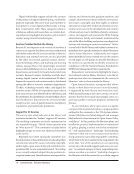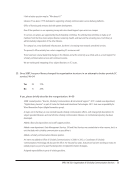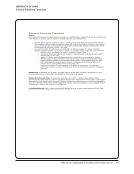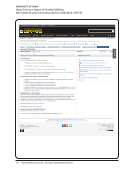SPEC Kit 332: Organization of Scholarly Communication Services · 21
The director of our center for scholarly communication &digital curation has primary responsibility for providing
leadership in this area, although she works closely with a scholarly communications committee and with library
administration.
The program manager, scholarly publishing &licensing, who is head of the office of scholarly publishing &licensing, has
primary responsibility. This individual works very closely with the director’s office and with subject liaisons.
There is also a scholarly communication steering committee consisting of librarians that reports to me, and several other
people who play key leadership roles. These include the head of our engineering library (who also chairs the SC steering
committee), the head of our digital initiatives unit (which manages our IR, supports OJS publishing and performs other
SC support work), and our head of access services, who is the Libraries’ copyright officer. None of these people report
directly to me.
We have a coordinator for scholarly communications (1 FTE) and another scholarly communication librarian (.75 FTE).
Two or More Individuals
Administrative group called the Management Team.
The scholarly communication librarian has primary responsibility for leading education and outreach activities. A
component of outreach activities coordinated by the SC librarian is promoting awareness of scholarly communication
issues. Primary responsibility for the development and implementation of scholarly communication services rests with a
number of individuals within the library, varying according to the specific service. For example, campus-based publishing
efforts are led by the digital scholarly publishing officer. Responsibility for the hosting and managing of digital content,
as well as support with research, publishing, and creative works, rests with a number of individuals and departments.
The librarian for digital scholarship initiatives has primary leadership responsibility for a number of services falling
under these categories. Individuals with primary leadership responsibility for SC services are located within different
departments and units within the library’s organization structure, rather than within a single department/unit.
The umbrella of activities relating to advancing change in scholarly communication practices is distributed across a
number of units within the Libraries. In addition, the separately managed health sciences library on campus also pursues
various activities advancing change in scholarly communication. As appropriate, some activities are coordinated, but
many require minimal direct coordination.
Library Office, Department, or Unit
Our office of scholarly communication is a department of three librarians, one staff assistant, and several student
assistants. The office takes its direction from the scholarly communication &special initiatives librarian, who reports
to the director of libraries. We also have a team that meets twice a month to review our initiatives and projects, and a
committee that helps provide direction for the department. The team consists of seven librarians, and the committee
consists of five librarians. There is some staff overlap between the team and the committee.
Responsibility for strategy and program development is at the associate dean level, but we have also had a librarian
with the title “Head, Scholarly Communications Services.” We are in the middle of creating a new unit that will likely be
called “Publishing and Curation Services” which will include that librarian, the digital collections curator, and staff TBD.
The responses in this survey thus primarily reflect the activities of those librarians prior to the creation of this unit.
The digital services division has primary responsibility for SC, but also works closely with a librarian from the law library
with copyright expertise as well as partnering with others on campus.
The office for copyright and scholarly communications will undergo a change this year, with the addition of a second
full-time staff member, in addition to the director and an intern. Up until that time, the persons responsible have not
The director of our center for scholarly communication &digital curation has primary responsibility for providing
leadership in this area, although she works closely with a scholarly communications committee and with library
administration.
The program manager, scholarly publishing &licensing, who is head of the office of scholarly publishing &licensing, has
primary responsibility. This individual works very closely with the director’s office and with subject liaisons.
There is also a scholarly communication steering committee consisting of librarians that reports to me, and several other
people who play key leadership roles. These include the head of our engineering library (who also chairs the SC steering
committee), the head of our digital initiatives unit (which manages our IR, supports OJS publishing and performs other
SC support work), and our head of access services, who is the Libraries’ copyright officer. None of these people report
directly to me.
We have a coordinator for scholarly communications (1 FTE) and another scholarly communication librarian (.75 FTE).
Two or More Individuals
Administrative group called the Management Team.
The scholarly communication librarian has primary responsibility for leading education and outreach activities. A
component of outreach activities coordinated by the SC librarian is promoting awareness of scholarly communication
issues. Primary responsibility for the development and implementation of scholarly communication services rests with a
number of individuals within the library, varying according to the specific service. For example, campus-based publishing
efforts are led by the digital scholarly publishing officer. Responsibility for the hosting and managing of digital content,
as well as support with research, publishing, and creative works, rests with a number of individuals and departments.
The librarian for digital scholarship initiatives has primary leadership responsibility for a number of services falling
under these categories. Individuals with primary leadership responsibility for SC services are located within different
departments and units within the library’s organization structure, rather than within a single department/unit.
The umbrella of activities relating to advancing change in scholarly communication practices is distributed across a
number of units within the Libraries. In addition, the separately managed health sciences library on campus also pursues
various activities advancing change in scholarly communication. As appropriate, some activities are coordinated, but
many require minimal direct coordination.
Library Office, Department, or Unit
Our office of scholarly communication is a department of three librarians, one staff assistant, and several student
assistants. The office takes its direction from the scholarly communication &special initiatives librarian, who reports
to the director of libraries. We also have a team that meets twice a month to review our initiatives and projects, and a
committee that helps provide direction for the department. The team consists of seven librarians, and the committee
consists of five librarians. There is some staff overlap between the team and the committee.
Responsibility for strategy and program development is at the associate dean level, but we have also had a librarian
with the title “Head, Scholarly Communications Services.” We are in the middle of creating a new unit that will likely be
called “Publishing and Curation Services” which will include that librarian, the digital collections curator, and staff TBD.
The responses in this survey thus primarily reflect the activities of those librarians prior to the creation of this unit.
The digital services division has primary responsibility for SC, but also works closely with a librarian from the law library
with copyright expertise as well as partnering with others on campus.
The office for copyright and scholarly communications will undergo a change this year, with the addition of a second
full-time staff member, in addition to the director and an intern. Up until that time, the persons responsible have not














































































































































































